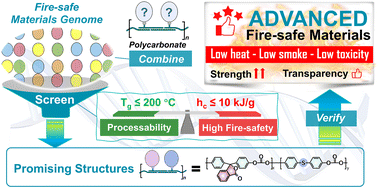Efficiently predicting and synthesizing intrinsic highly fire-safe polycarbonates with processability†
Abstract
High fire-safety is extremely required for polymer materials applied in many social environments, but the contradiction between fire-safety and processability for molecular design of intrinsic highly fire-safe polymers has remained a challenge, so perfect polymer candidates meeting the above requirements are greatly lacking. Traditional design based on scientific intuition and trial-and-error experimentation is time-consuming and rather inefficient; herein, we establish a simple material genome approach (MGA) allowing high-throughput screening of intrinsic fire-safe and processable polycarbonates (PCs). A bisphenol unit was chosen as the “gene” of PC chains, and the glass transition temperature and the total heat release were key intrinsic parameters indicative of processability and fire-safe performance, respectively. Two PCs with optimized chemical structures were successfully predicted and synthesized. More excitingly, the predicted PCs show excellent comprehensive performances, and the novel mechanism for outstanding fire-safety performance has been found. This work provides an efficient guide in the design and synthesis of processable highly fire-safe polymers.



 Please wait while we load your content...
Please wait while we load your content...